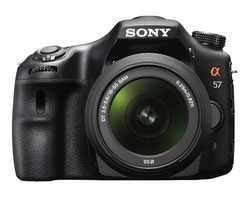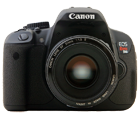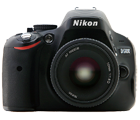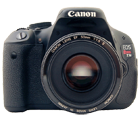Sony SLT A57 Review
As I prepared to write this Sony SLT A57 review, I had to keep reminding myself of one thing:
This camera is NOT an SLR in the strictest sense.
From the outside, the Sony SLT A57 could easily be mistaken for one — the body shape is essentially the same. The real differences lie on the inside of the camera.
The most substantial difference between the Sony SLT A57 and a "true" digital SLR is that the SLR has an optical viewfinder while the one on the Sony is electronic.
A second big difference is what gives the SLT its name: instead of a "reflex" mirror system (the "R" in SLR) the Sony has a "translucent" mirror system — hence, SLT.
The translucent mirror and electronic viewfinder mean that this camera behaves quite differently from other "traditional" SLRs, and I'll explain these differences in the rest of this Sony SLT A57 review.
Let's get started!
Table of Contents
| Translucent Mirror | Full-Time Autofocus | Electronic Viewfinder |
| Flexible LCD | Speed | ISO Performance |
| Beginner Modes | Movie Mode | Bonus Features |
| Overall Summary | Packages and Pricing | Image Gallery |
Translucent Mirror
To understand the need for a translucent mirror, some history is required.
When digital SLRs first came out, the ONLY way you could take pictures was by using the viewfinder: you could not use the LCD screen on the back of the camera to take pictures, but you could review what you had already taken.
This is because inside an SLR there is a mirror that sits in front of the camera's sensor. The mirror reflects what the lens "sees" up to the viewfinder.
Eventually there was a breakthrough development called live view: in this mode, the mirror was moved up and out of the way of the sensor so that a "live" image could be displayed on the camera's LCD screen.
It was great to be able to have the flexibility to compose using either the viewfinder OR the LCD, but live view came with a huge drawback: when the mirror was UP, it blocked the camera's fast autofocus system.
In live view mode, many digital SLRs focus at the speed of a compact camera: in other words, autofocus is incredibly slow and innacurate.
The innovation inside the Sony SLT A57 is a semi-transparent mirror that does two jobs at once:
- It reflects some light passing through the lens to a viewfinder
- It allows light to pass through to the camera's sensor
This means that you can use either the viewfinder or the LCD to compose your photos with no loss of autofocus speed or precision.
Furthermore, that same high-speed autofocus is still in effect when you want to shoot video which is good news for anyone who wants to make movies of fast-moving subjects.
Full-Time Autofocus
Thanks to its special mirror, the Sony SLT A57 autofocus runs at top speed in all camera modes.
Since I have used many other digital SLRs with their slow live view modes, the first thing I wanted to investigate for this Sony SLT A57 review was its autofocus system.
Right after receiving the camera, I toted it along to a nearby park to see what it could do.
This particular park is a great place to put an autofocus system through its paces, because there are SO many different kinds of plants layered on top of each other.
For example, I will try to take a picture of a single flower or plant even though it is obscured by other plants in the foreground.
The autofocus on the SLT A57 performed very well and was able to lock focus within fractions of a second.
What's really remarkable is that there is NO difference in the autofocus speed switching from the viewfinder to the LCD to compose photos. In fact, after about 5 minutes I found myself using the LCD more frequently that the viewfinder.
In addition to static subjects, the autofocus on the SLT A57 is able to lock and track moving subjects with Tracking focus. In this mode, you designate the subject you want the camera to track, and you can watch the autofocus stay locked on the subject as it moves across the LCD.
Face-detection autofocus does the same thing when you are taking portraits.
Small white autofocus squares settle on top of all of the faces that appear on the LCD, and they stay locked on the faces even if your subjects don't stay perfectly still.
Electronic Viewfinder
The one feature that I really wanted to explore for this Sony SLT A57 review is the electronic viewfinder.
I've read extensively about what a technical marvel this viewfinder is, a display that is made up of 1.44 million dots (the more dots, the higher the image quality).
Having used it, I can now say this: it does have some advantages, but it's NOT the same as an optical viewfinder.
Since an optical viewfinder is made up of mirrors, you see exactly what the lens sees. Colors, clarity and motion are all identical to the scene in front of you.
By contrast, the electronic viewfinder must artifically reproduce whatever image the sensor is capturing.
Imagine for a moment standing in front of a spectacular fall landscape. The trees are a vibrant orange color, the ground a rich brown and the dappled sunlight is just perfect.
You put the camera to your eye...and suddenly the scene in front of you doesn't look quite so glorious.
This is because the electronic viewfinder must "translate" all the colors in front of you into colored pixels and - if it's not a perfect match - all the colors look wrong.
Taking pictures of vibrant flowers I eventually stopped using the viewfinder completely and just used the LCD for composition.
I had to HOPE that the colors being captured by the sensor were somewhat better than the colors I was seeing in the viewfinder.
Now that you're aware of its limitations, lets talk about a bonus feature of the viewfinder that is simply not possible with mirrors: the horizon line.
As you look through the viewfinder, you see a line running horizontally across the center.
When you tilt the camera, the line tilts as well, indicating that the camera is not level. This same indicator shows you if the camera is pointed up or down.
I found the horizon line very useful when taking landscape photos, since I have an especially hard time keeping my horizons level.
Flexible LCD
The flexible 3 inch LCD screen on the Sony SLT A57 is the type that folds down from the bottom of the camera, much like the Nikon D5000.
While this does allow for a great deal of flexibility, it also prevents you from using the flexible LCD when the camera is attached to a tripod. This is a non-issue with LCD screens that flip out from the SIDE of the camera body, like the one on the Canon Rebel T4i 650D.
Despite this minor shortcoming, the LCD screen on the SLT A57 is exceptionally clear.
I used it extensively to compose my photos since there is no difference in autofocus speed between it and the viewfinder.
I also used the LCD flipped out from the bottom of the camera for video capture. In this position, I could hold the camera almost at ground level and look straight down at the screen to make sure that I was framing my scene correctly.
In addition to aiding with composition, the LCD screen is also used to change camera settings and playback images.
I liked the quick access to all of the major camera settings with a press of the function (Fn) button on the back of the camera.
After you press the Fn button, two vertical menus display down the left and right side of the LCD. Using the directional keypad, you can make quick adjustments to settings like: metering mode (area, spot, etc.), autofocus mode, ISO, smile shutter, color modes, HDR and Dynamic Range Optimization (DRO), drive mode (one-shot, continuous high, continuous low, self-timer, etc.) and filter effects (see below).
Speed
I knew that this camera was fast so I wanted to give it a workout for this Sony SLT A57 review.
In my mind, there's nothing quite like a soccer game to challenge both the autofocus as well as the continuous shot speed of a digital SLR.
Before I describe what the A57 is capable of, I'll explain WHY it is so fast.
The continuous shot speed of most digital SLR cameras is limited by the movement of the mirror. The mirror that blocks the sensor must flip up out of the way for each and every shot.
The majority of mirrors can only open and close at a rate of about 4 times per second, but some high-end (and expensive) ones are capable of 8.
Since the Sony SLT A57 doesn't need to move the mirror each time it takes a picture, it can rip along at 12 photos per second.
If you're a parent with kids that play sports this is a beautiful thing.
At 12 photos per second, you can capture bursts of images right at key moments during the game. Later, you can pick the one photo that really captures the action at its peak.
Taking pictures of my daughter's soccer game, I noticed that each burst of images winds up looking like a flip book: play them back in sequence fast enough, and you get an animated scene.
Of course, all the speed in the world wouldn't matter much if the images were out of focus, but I found no such issues with the SLT A57.
The continuous autofocus kept pace with my daughter as she ran all over the field, even as I struggled to keep her in the frame.
ISO Performance
When I first started reviewing digital SLR cameras back in 2005, I paid attention to how well they handled image noise at high ISO settings.
ISO is a feature on any digital SLR that lets you set how sensitive the sensor is to light: the higher the ISO, the higher the sensitivity.
However, high ISO levels come wih a drawback: the higher you get, the more speckled your photo looks. This speckling is often called "grain" or "image noise".
Digital SLRs used to max out at ISO 3200 and even at ISO 1600 the image noise was very apparent.
Flash forward to today and take a closer look at the photos below: noise is somewhat visible at ISO 6400 but doesn't really become obvious until ISO 12800.
It's astonishing to me how well the Sony SLT A57 minimizes high-ISO noise. This provides photographers with the ability to use any ISO they want, without having to fret about how much it is degrading the quality of their photos.
Beginner Modes
No doubt about it: the Sony SLT A57 is simply packed with features.
You can customize virtually every setting on this camera: color tone, contrast, image quality, autofocus area, level of dynamic range, creative image filters....the list goes on and on.
The good news for beginners is that you can get to a lot of the most important camera modes from a single dial.
The main mode dial provides you with access to the following:
- Intelligent Auto — determines the subject of your photo and changes settings accordingly
- Superior Auto — same as Intelligent Auto with access to more features like High Dynamic Range (HDR) and continuous shooting
- Program Auto — camera selects aperture and shutter speed, all other settings can be changed by photographer
- Flash Off — Intelligent Auto with the flash disabled
- Scene — choose from a variety of specific scene modes
- Sweep Panorama — lets you take panoramic photos by moving the camera from left to right
- 3D Sweep Panorama — creates 3D panoramas for viewing on 3D-enabled TVs
- Continuous Priority AE — sets the camera in full high-speed mode for action photography
- Movie — mode for capturing video
- Manual Modes (A, S, M) — Aperture Priority, Shutter Priority and full Manual exposure modes
Every time you select one of these options on the main mode dial, the LCD displays some brief instructions (as have done above) about WHAT the mode is used for.
This is useful for beginners and anyone not familiar with Sony's icons for all of their different modes.
In addition to the mode dial tips, you can also get information about ANY camera setting by pressing the Help (?) button on the back of the camera when that feature is selected on the LCD screen.
Movie Mode
The most notable things about the Sony SLT A57 movie mode are the continuous autofocus and the clarity of the end result.
I mentioned at the beginning of this Sony SLT A57 review that traditional DSLRs have pretty slow autofocus when you put them in live view or movie mode.
Even with advanced cameras like the Canon Rebel T4i 650D I often resort to manual focus in movie mode to ensure that the autofocus doesn't keep shifting the focus point.
There are no such issues with the Sony SLT a57: autofocus shifts seamlessly during movie capture to track moving subjects and to adjust when you zoom the lens.
Take the video below as an example and note how there's never a point where the image looks "accidentally" out of focus.
However, this continuously shifting autofocus does come with a drawback that you should be aware of when using the SLT A57 for videos: depending on the lens you're using, the sound of the lens adjusting focus can be quite loud on the soundtrack.
There are three ways to address this issue:
- Focus Manually — no lens noise, but tracking moving subjects is a LOT harder
- Use a Quiet Lens — for this SLT A57 review I used the Sony 18-200mm which makes a pretty loud noise when it focuses; look for a lens with a quiet focus motor
- Get a Microphone — the built-in microphone is on the top of the camera, close to the lens; an accessory microphone won't pick up lens noise as much
Once you've tackled the issue of sound, there are several different image quality settings you can choose from:
- 60 frames per second interlaced, maximum quality
- 60 frames per second interlaced, fine quality
- 60 frames per second progressive, maximum quality
- 24 frames per second progressive, maximum quality
- 24 frames per second progressive, fine quality
About the only valid reason I saw to reduce the quality of the video image on the SLT A57 was if you wanted to conserve space on your memory card.
I was using a relatively modest 8GB SD card for this SLT A57 review, and never came close to filling it up despite taking many photos and several videos as the highest quality setting.
Bonus Features
The Sony SLT A57 includes several features that - while not for everyday use - set this camera apart from its competition.
The first is Sweep Panorama.
In this mode (which you select on the main mode dial) you press down once on the shutter release button and then pan the camera from left to right.
The SLT A57 displays an arrow that shows the direction you should pan, and it also indicates how fast or slow you should move the camera to create a panorama.
Once complete, the A57 stitches together all the images that it captures into a single panoramic photo.
Not every subject will lend itself to a panorama but in some cases - Grand Canyon anyone? - this feature will help you take photos that would take you a lot of time to create with other digital SLRs.
The second bonus feature is Smile Shutter.
Smile Shutter is a setting of the face-detection autofocus system and it's definitely the sort of "party trick" that other cameras don't have.
Once enabled, the A57 will automatically take a photo of a person the minute they smile. If they are frowning or not smiling, the camera waits. The minute they break a smile, a picture is taken.
This is a great feature if you have family members reluctant to smile in front of a camera — you can just tell them that the camera won't take a picture until they grin.
I found that it's also a great tool when your kids want to "borrow" the camera to take pictures. All the child has to do is point the camera in your direction and as soon as you smile, the moment is captured.
Extra feature #3 is Portrait Crop.
I discovered - quite by accident - that this is also useful if you want to lend your camera to younger kids to let them take pictures.
My children, who have never expressed any interest in all the cameras that have come and gone over the years, decided that they wanted to take some pictures of me using the SLT A57.
With portrait crop enabled, it didn't matter how far away they were when they took my picture. The SLT A57 captures the photo, and then immediately creates a second image that is cropped to improve the framing of the subject.
The fourth feature is Creative Filters.
Creative filters are not unique to the Sony SLT A57. They are all the rage these days and are available on other digital SLRs like the Canon Rebel T4i 650D and the Nikon D5100.
These "filters" let you apply different effects to your photos as they are taken. You could apply similar effects using software, but you'd have to spend considerable time in front of your computer to do so.
I tried out every single one of the filters for this Sony SLT A57 review, and the results are below:
|
Toy Camera
|
Pop Color
|
|
High Contrast Monochrome
|
Retro Photo
|
|
Soft High-key
|
Rich-tone Monochrome
|
|
Soft Focus
|
HDR Painting
|
|
Posterization
|
Miniature
|
The last special feature of the SLT A57 is Auto HDR.
HDR stands for "High Dynamic Range" and it attempts to capture detail in shadows and highlights at the same time.
Imagine any photograph you've taken where part of the scene is in shadow and part is in full sunlight. One of two things happens: either the part in sun appears pure bright white or the part in shadow is almost pure black.
HDR images are actually a blend of images, not a single photo. To create an HDR image, you take 3 or more separate photos, where the exposure is changed for each image: some darken the highlights and others brightens shadows.
When these images are merged you get a single image with greater tonal range, or higher dynamic range.
Since the SLT A57 can rip through 12 photos a second, it can capture 3 consecutive photos with different exposures almost instantly. The software inside the camera creates the blended image for you so you don't have to spend a single minute in front of your computer.
Summary
I enjoyed using the Sony SLT A57 for this review and was especially impressed with the speed and performance of the camera.
Sony certainly breaks some speed records and this helps action photographers capture a lot of fleeting moments, fractions of a second frozen in time.
The movies captured by the A57 are also smooth, clear and colorful. It's easy to frame your videos in unique ways by leveraging the flexible LCD screen.
My biggest issue with the camera is the electronic viewfinder.
Perhaps at some point in the not-so-distant future, I will look back on this and be surprised to find myself criticising a technology that might become quite common.
The electronic viewfinder certainly has potential, and the non-moving mirror overcomes a LOT of limitations that are still present on other digital SLR cameras.
But at the end of the day, I really missed the clarity of an optical viewfinder.
When digital SLRs first became available, there was an on-going argument about whether or not they could ever replicate the quality of film. Film purists said they would never go "digital" because the look of film could not be replicated.
Today, with 18 and even 24 megapixels and virtually no noise even at ISO 6400, the digital sensor has replaced analog film.
So at some point the electronic viewfinder might replace the optical one...but there are still some significant improvements to be made in terms of both color fidelity and clarity.
I'll leave you with this thought: if you've never used an SLR before this issue may not matter to you at all. Since you haven't been exposed to optical viewfinders, this electronic one may work just fine. Of course, you can also take pictures JUST using the LCD.
However, if you've used a film or digital SLR in the past, then you should definitely try out a Sony SLT A57 at a camera shop before you buy to see if you're OK with the viewfinder.
If you are, and need a camera that can keep up with all of your high-speed adventures, then the Sony SLT A57 might just be the right quasi-SLR for you.
Sony SLT A57 Packages, Pricing and Accessories
Sony SLT A57 Photo Samples
See more of the photos that I captured for this Sony SLT A57 review.

|
































